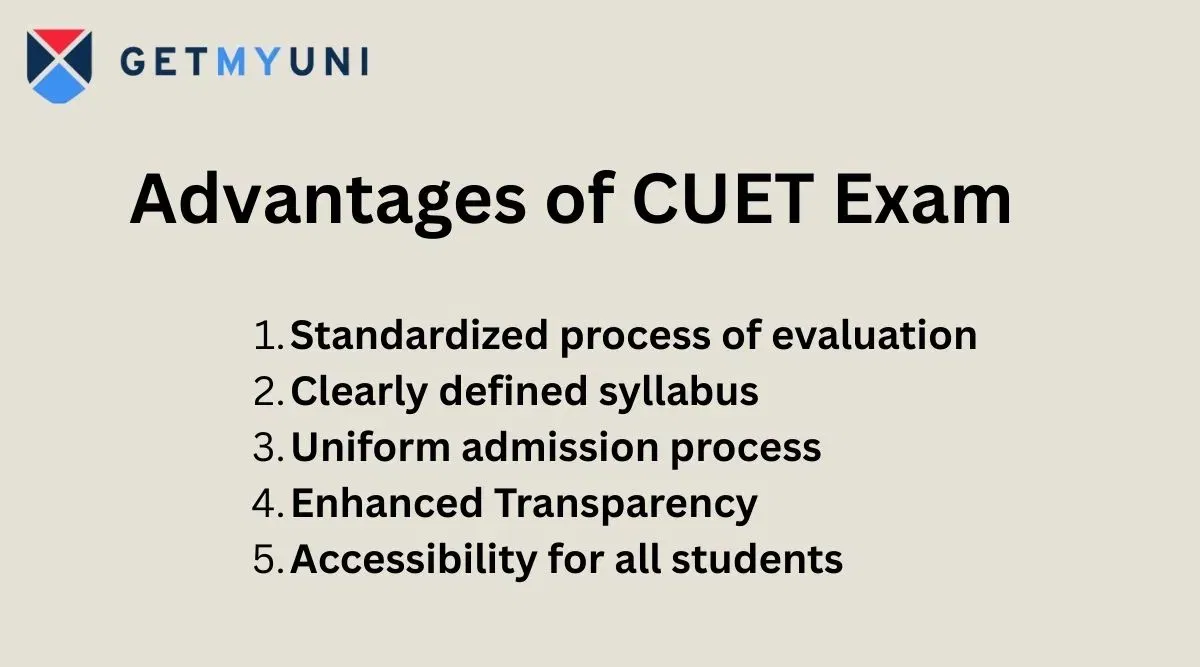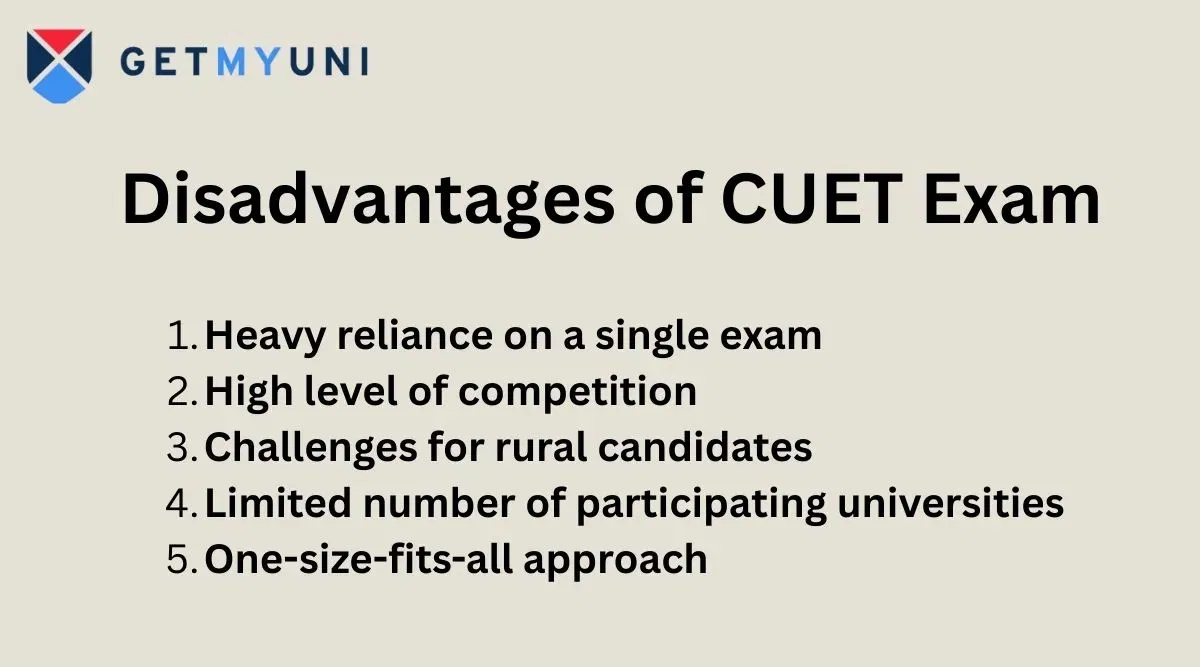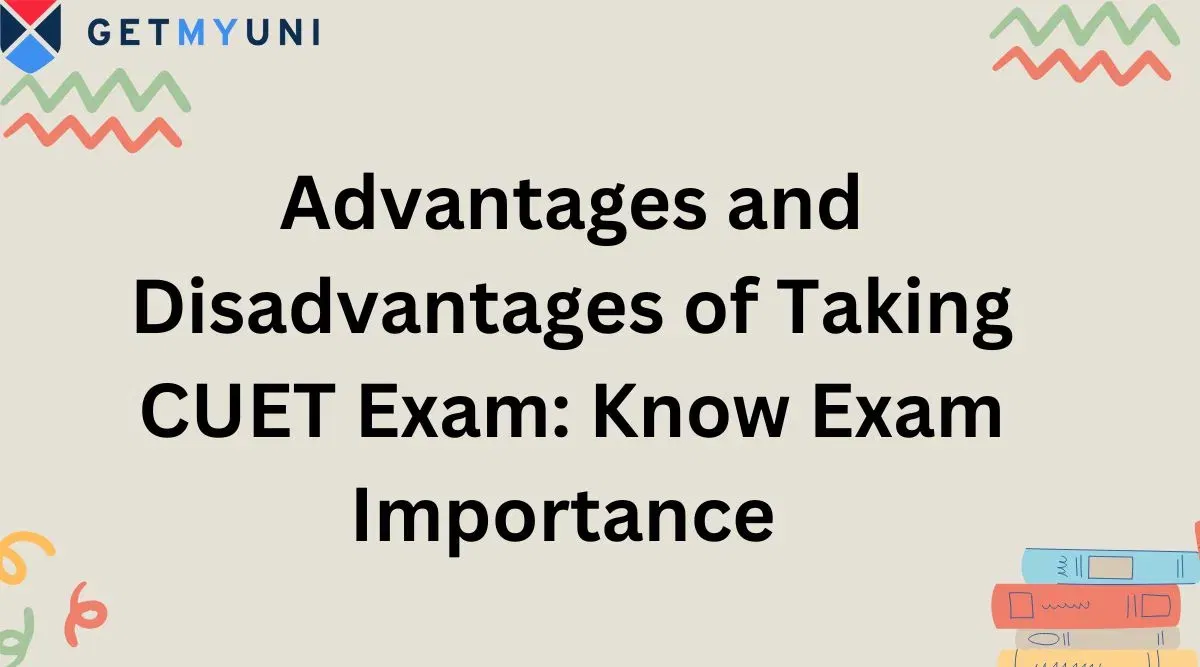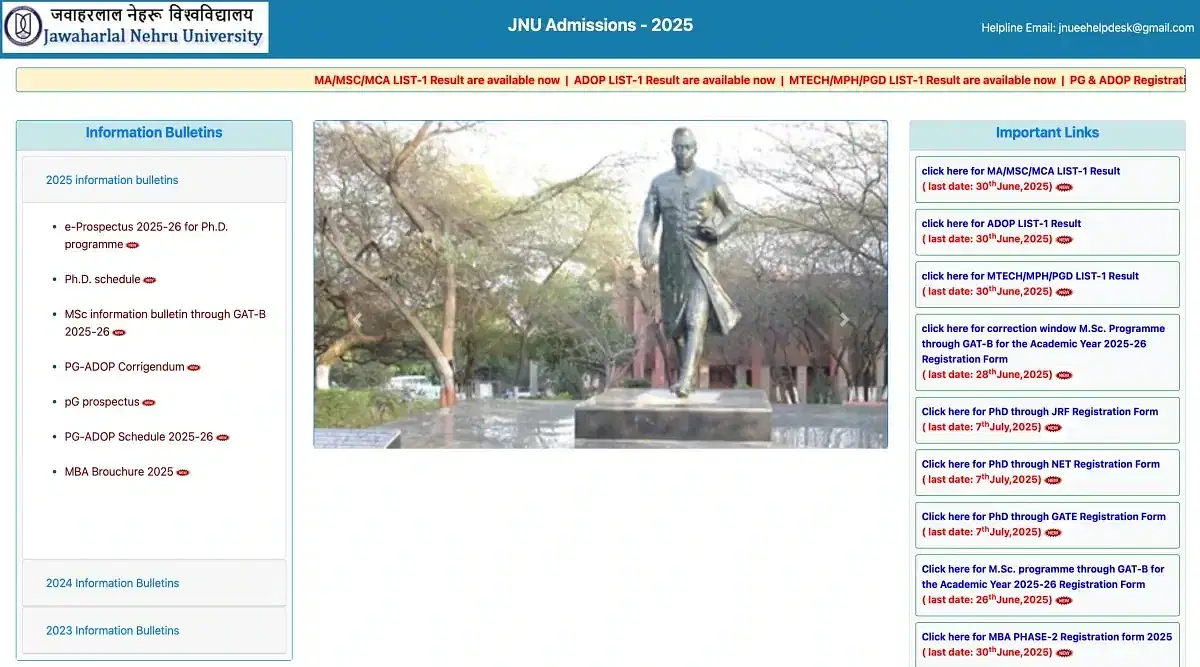To understand the advantages and disadvantages of taking CUET exam is that it is a unified admission process, wider college options, and transparency — along with disadvantages like high competition, syllabus pressure, and limited retake opportunities.
Table of Contents
The Common University Entrance Test (CUET) is a national-level entrance examination introduced by the Government of India. It evaluates you at both undergraduate and postgraduate levels in participating universities and standardizes the admission process.
CUET is designed to replace multiple entrance exams conducted by individual universities. It ensures transparency and a simplified procedure that benefits you and the institution. While CUET offers many advantages, it comes with its challenges. In this article, we will focus on the perspective of the CUET examination, delving into its relevance and implications for students and the entire system.
Advantages of Taking the CUET Exam 2026
Common University Entrance Test (CUET) is an initiative introduced to streamline the process of admission both for the students as well as for the institutions. Some of the major advantages are as follows:

1. Standardized process of evaluation
CUET ensures that you nationwide have a fair platform of judgement. It levels the test to a particular level that is the same for every student. This eliminates any disparities caused by syllabi or grading systems, as the assessment is based on a common syllabus.
2. Clearly defined syllabus
CUET provides a clearly defined syllabus. The syllabus provides clear and concise guidelines on how and what to prepare for the examination. It provides a structured framework, leaving no space for confusion and anxiety.
3. Uniform admission process
CUET brings together the admission process of multiple universities on a single platform. This ensures a hassle-free process for the students and eliminates the requirement of multiple entrance exams. Also, this single process of admission saves time, effort, and money making it easier for the candidates to indulge in the process.
4. Enhanced Transparency
CUET promotes a merit-based admission system. A centralized evaluation and scoring system enhances transparency as it reduces the chance of manipulation in the admission process.
5. Accessibility for all students
CUET is conducted in multiple languages at multiple centers making it accessible for the students coming from different backgrounds. CUET ensures to offer access to diverse linguistic and regional background candidates. This type of inclusivity ensures equal and better opportunities for students.
Also Read: How to Calculate CUET Score 2026?
Disadvantages of Taking the CUET Exam 2026
You can check the disadvantages of taking the CUET exam 2026 from the list explained below.

1. Heavy reliance on a single exam
CUET acts as the sole exam and admission criteria for participating universities. It is one single exam connecting all the universities and because of it if you doesn't succeed in it, it can jeopardize your chance for a future at a reputed institution.
2. High level of competition
As CUET is a solo exam among the participating universities, the number of applicants is huge which creates a extreme competition. This fierce competition makes it difficult for you to achieve success in the exam leading to not securing of seats in the desired university.
3. Challenges for rural candidates
If you are from the rural areas you have limited access to technology and resources and so, it becomes difficult for them to prepare and appear for the national level examinations like CUET. Unfamiliarity of the candidates due to limited access to technology can act as one of the biggest disadvantages of CUET.
4. Limited number of participating universities
CUET allows only central universities as the participating universities. Students who want to get admission in the private universities or state universities have to appear for different examination which is a hassle in itself.
5. One-size-fits-all approach
The standardized nature of CUET does not fit the specific needs of specific courses which affects the effectiveness of admission for niche programs. One size fir approach limits the focus on individualistic programs needs and follows similar pattern of examination for majority of the programs.
Also Read: Universities Offering Admissions without CUET Scores 2026
Importance of CUET Exam 2026
CUET assesses the students through on a single platform through a standardized procedure. This exam joins the participating universities together and bridges the gap between them by emphasizing on uniform syllabus and one-size-fits-all approach for admission in any of the universities.
1. Unified Admission Process
CUET provides a single platform for students to apply to multiple universities. This eliminates the need for appearing in numerous university-specific entrance exams, simplifying the process and reducing the stress and financial burden on students.
2. Equal Opportunity for All Students
In India, educational boards follow different syllabi and evaluation standards, leading to disparities in student performance. CUET bridges this gap by offering a uniform test, ensuring that all candidates are assessed based on a common standard, regardless of their board or region.
3. Expanding Access to Higher Education
CUET allows students to apply to central, state, and private universities using a single score. This provides access to a larger number of institutions, especially for students from remote or underprivileged areas, who may not have been aware of opportunities in distant universities.
4. Focus on Subject Proficiency
The CUET exam is designed to evaluate students based on their knowledge of specific subjects of their choice. This enables candidates to demonstrate their expertise in areas they are genuinely passionate about, increasing their chances of pursuing their preferred courses.
5. Transparency and Fairness
The NTA ensures a transparent examination process by providing answer keys, question papers, and a mechanism to challenge answers. This guarantees fair evaluation and builds trust in the system.
6. Reduction in Financial Burden
By consolidating the admission process into one examination, CUET reduces the financial strain on students and their families. Candidates no longer need to spend money on multiple entrance tests, application fees, and travel expenses.
7. Encourages Academic Focus
CUET shifts the focus from rote learning to academic understanding. Students are assessed on their knowledge and skills in specific subjects rather than merely on their board exam performance, encouraging deeper learning.
8. Promotes Diversity in Universities
With CUET, universities can attract a more diverse pool of students from across the country. This enriches the campus environment and fosters inclusivity, as students from various regions, cultures, and backgrounds come together.
9. Simplifies Admission for Universities
For universities, CUET streamlines the admission process by centralizing applications. Institutions can rely on CUET scores to admit students, reducing administrative overhead and ensuring uniform evaluation criteria.
10. A Step Towards National Education Policy (NEP) Goals
CUET aligns with the objectives of the National Education Policy (NEP) 2020, which emphasizes inclusivity, accessibility, and the integration of technology in education. By standardizing admissions, it promotes the vision of creating a unified and equitable education system.
Must Read: Central Universities Admission Through CUET UG 2026
Conclusion
The Common University Entrance Test (CUET) is a transformative step towards the Indian education system, as it promotes standardized admission process through a single entrance exam. It ensures transparency in the university admission process. CUET navigates students through the challenges of admission process by streamliing the process for them in the form of structured and reliable form of syllabus for the examination. With such strong advantages also comes some of its major disadvantages which can't be forgone.
Ultimately, CUET is taking initiatives which is aligning with the future of education in India. It is ensuring to provide common platform to the students for every academic opportunity in higher education.























POST YOUR COMMENT